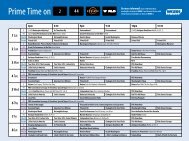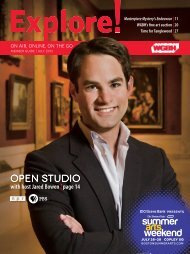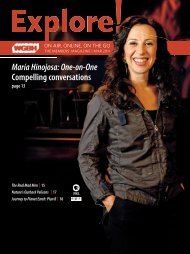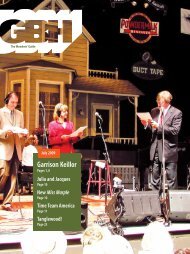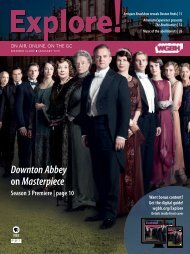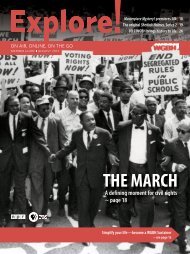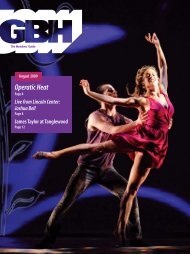Download program notes and libretto - WGBH
Download program notes and libretto - WGBH
Download program notes and libretto - WGBH
You also want an ePaper? Increase the reach of your titles
YUMPU automatically turns print PDFs into web optimized ePapers that Google loves.
A taste for French dances is something that Steffani acquired in<br />
Paris <strong>and</strong> which distinguishes him from his compatriots. The<br />
minuet, gavotte, bourrée, <strong>and</strong> sarab<strong>and</strong>e underpin many of his<br />
arias <strong>and</strong> ensembles, <strong>and</strong> the instruments that alternate with<br />
the vocal lines are occasionally reduced to two oboes <strong>and</strong><br />
bassoon—a combination favored by Lully. Some of these<br />
movements were danced as well as sung. The acts of Steffani’s<br />
operas normally end with a ballet, for which the music often<br />
has been lost, <strong>and</strong> his operas invariably begin with a French<br />
overture, even if it is called a “sinfonia.” His writing for strings<br />
<strong>and</strong> woodwinds in dance-based movements <strong>and</strong> overtures was<br />
heavily influenced by what he heard in Paris, <strong>and</strong> his fusion of<br />
French <strong>and</strong> Italian styles, combined with skillful counterpoint,<br />
helped forge the musical language of the late Baroque.<br />
a b<br />
Premiered in the Salvatortheater at Munich on January 5, 1688,<br />
Niobe, Regina di Tebe was Steffani’s first opera based on Greek<br />
myth.The <strong>libretto</strong> was by Luigi Orl<strong>and</strong>i, a court secretary who<br />
had supplied him with the text of 1687’s Alarico il Baltha.The<br />
most important source for Niobe was Book VI of Ovid’s<br />
Metamorphoses.The moral of the opera is“pride comes before<br />
a fall,”but the work is concerned also with the power of music.<br />
The influence of sorcery <strong>and</strong> the supernatural is reflected in<br />
Orl<strong>and</strong>i’s request for numerous sets <strong>and</strong> spectacular stage<br />
machinery. Ballets at the ends of the acts—<strong>and</strong> in Act II, Scene<br />
IV, when Anfione (Amphion) is made a god—were devised by<br />
the court choreographer <strong>and</strong> dancing master, François Rodier.<br />
The score of the opera is exceedingly rich. Its musical language<br />
reaches heights of intensity in melody <strong>and</strong> harmony, <strong>and</strong> its<br />
orchestration is exceptionally finely conceived <strong>and</strong> precisely<br />
notated. Niobe is also the first Steffani opera with fewer than<br />
sixty arias <strong>and</strong> five ostinato basses. Many of the arias are<br />
accompanied by instruments in addition to continuo.Ten extra<br />
musicians were engaged for the production: a document in the<br />
Bavarian state archives records their names <strong>and</strong> the amounts<br />
they were paid for seven rehearsals <strong>and</strong> four performances.<br />
That Niobe is an exceptional score is announced by trumpets<br />
<strong>and</strong> drums in the overture, but the work’s most extraordinary<br />
features are associated with the role of Anfione, a vehicle for the<br />
castrato Clementin Hader <strong>and</strong> a tribute to Max Emanuel (a<br />
musician as well as a soldier). Eight ofAnfione’s ten arias call for<br />
additional instruments, <strong>and</strong> in five of them—an unusually high<br />
number—the instruments play throughout. The scoring is<br />
particularly rich in the Palace of Harmony (Act I, Scene XIII),<br />
where the king seeks comfort from worldly affairs. Here he is<br />
accompanied on stage by “viole” <strong>and</strong> “bassi,” <strong>and</strong> in the<br />
orchestra by recorders <strong>and</strong> strings (two players per part);<br />
plucked instruments (harpsichords <strong>and</strong> theorboes) are silent.<br />
The recitative is introduced by the on-stage instruments; these<br />
being hidden (“in scena nascosti”), the music sounds ethereal<br />
<strong>and</strong> soothing.The orchestra enters when Anfione starts singing,<br />
<strong>and</strong> breaks into repeated chords as he tries to throw off his cares,<br />
but the “viole” continue to provide a sustained background,<br />
f e s t i va l o p e ra<br />
suggesting the impassivity of the universe. The aria “Sfere<br />
amiche, hor date al Labro,” invokes the music of the spheres.<br />
The circling of the planets is captured in a six-quarter-note<br />
ostinato—the aria is in 6/4—that begins on the subdominant<br />
note of the scale <strong>and</strong> is drawn down as if by gravity.These falling<br />
phrases in the bass are counterbalanced by rising motion above;<br />
furthermore, when the violins move, the “viole” are generally<br />
stationary, <strong>and</strong> vice versa. In this way the effect of rotation<br />
created by scales in contrary motion is reinforced by alternation<br />
between stage <strong>and</strong> pit. Finally, to lead smoothly into the da capo<br />
repeat, the second section ends (atypically) in the subdominant<br />
key, so that tonality, too, comes full circle.<br />
Most of Anfione’s arias are masterly <strong>and</strong> could be discussed in<br />
similar detail. In“Come Padre, e come dio”(Act I, Scene XXI),<br />
he persuades Jove to build walls around Thebes; in “Dal mio<br />
Petto o pianti, uscite” (Act II, Scene V), he trembles to staccato<br />
chords <strong>and</strong> weeps to chromatic scales; in “Trà Bellici carmi”<br />
(Act II, Scene XII), his desire for vengeance is conveyed by<br />
furious coloratura. He begins his last aria,“Spira già nel proprio<br />
sangue”(Act III, Scene XII), after stabbing himself in the chest,<br />
<strong>and</strong> leaves it incomplete at his death. As he expires, Niobe<br />
surveys in horror the demise of her offspring <strong>and</strong> husb<strong>and</strong>, <strong>and</strong><br />
voices a recitative.As she feels herself turning to stone, she sings<br />
a short continuo aria, “Funeste Imagini,” terrifying in its<br />
intensity, which also is left incomplete. Notwithst<strong>and</strong>ing her<br />
love songs to Anfione <strong>and</strong> Creonte, <strong>and</strong> her warlike“In mezzo<br />
al Armi”(Act III, Scene VIII), her final utterance is arguably the<br />
climax of her role. Creonte’s aria in the following scena ultima<br />
balances the overture in its use of trumpets <strong>and</strong> drums.<br />
Carefully balanced,also,are the roles of the young loversTiberino<br />
<strong>and</strong> Manto, who have six arias each. All but one of his are in<br />
common time, while most of hers are in triple. Her father Tiresia<br />
has two arias in 4/4 <strong>and</strong> major keys,<strong>and</strong> two in 3/4 <strong>and</strong> E minor.<br />
Poliferno’s exceptional status as a prince versed in magic explains<br />
why all four of his arias are supported by instruments, while the<br />
highlight of Clearte’s role is probably the accompanied recitative<br />
that he sings as Niobe’s children are slain (Act III, Scene X).<br />
The nurse,Nerea,st<strong>and</strong>s outside the action,serving as confidante,<br />
observer, <strong>and</strong> mediator between stage <strong>and</strong> auditorium. Her<br />
comic role—a staple of earlier opera <strong>and</strong> commedia dell’arte—<br />
is reflected in her arias, which are in lively tempos <strong>and</strong> major<br />
keys, with syllabic word-setting, syncopation, simple phrase<br />
structure, <strong>and</strong> much repetition. Most of the texts are wry<br />
observations on relations between men <strong>and</strong> women <strong>and</strong> their<br />
light-headed expectations of love. Two of her arias are linked:<br />
“Che agli assalti degli amanti” (Act I, Scene XVIII) points out<br />
that women cannot help falling for men, while “Che alla fè di<br />
Donne amanti” (Act III, Scene IX) states the opposite. To<br />
highlight this parallel,the music of the first aria is repeated for the<br />
second. The latter is a substitute for an earlier movement, still<br />
present in the score,<strong>and</strong> an example of the inspiration that pulses<br />
throughout Steffani’s greatest Munich opera. ■<br />
© Colin Timms<br />
135<br />
2 0 1 1 b o s t o n e a r l y m u s i c f e s t i v a l<br />
NIOBE, REGINA DI TEBE






